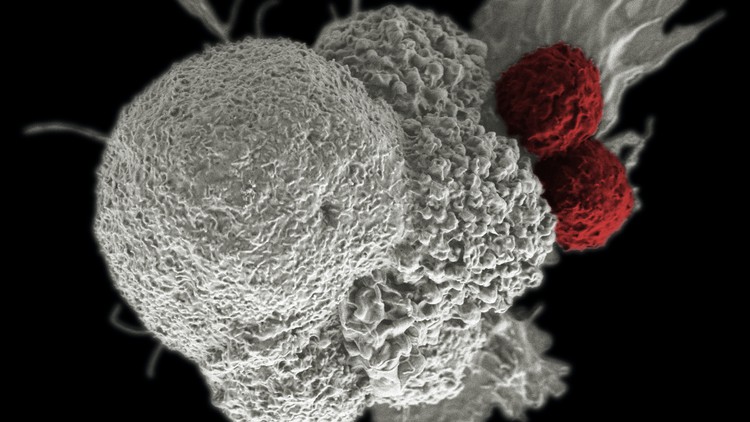Differential Gene Expression Analysis - Your Complete A to Z
- Description
- Curriculum
- FAQ
- Reviews
- Grade

Do you want to be a bioinformatician but don’t know what it entails? Or perhaps you’re struggling with biological data analysis problems? Are you confused amongst the biological, medicals, statistical and analytical terms? Do you want to be an expert in this field and be able to design biological experiments, appropriately apply the concepts and do a complete end-to-end analysis?
This is a comprehensive and all-in-one-place course that will teach you differential gene expression analysis with focus on next-generation sequencing, RNAseq and quantitative PCR (qPCR)
In this course we’ll learn together one of the most popular sub-specialities in bioinformatics: differential gene expression analysis. By the end of this course you’ll be able to undertake both RNAseq and qPCR based differential gene expression analysis, independently and by yourself, in R programming language. The RNAseq section of the course is the most comprehensive and includes everything you need to have the skills required to take FASTQ library of next-generation sequencing reads and end up with complete differential expression analysis. Although the course focuses on R as a biological analysis environment of choice, you’ll also have the opportunity not only to learn about UNIX terminal based TUXEDO pipeline, but also online tools. Moreover you’ll become well grounded in the statistical and modelling methods so you can explain and use them effectively to address bioinformatic differential gene expression analysis problems. The course has been made such that you can get a blend of hands-on analysis and experimental design experience – the practical side will allow you to do your analysis, while theoretical side will help you face unexpected problems.
Here is the summary of what will be taught and what you’ll be able to do by taking this course:
-
You’ll learn and be able to do a complete end-to-end RNAseq analysis in R and TUXEDO pipelines: starting with FASTQ library through doing alignment, transcriptome assembly, genome annotation, read counting and differential assessment
-
You’ll learn and be able to do a qPCR analysis in R: delta-Ct method, delta-delta-Ct method, experimental design and data interpretation
-
You’ll learn how to apply the knowledge of molecular biology to solve problems in differential gene expression analysis specifically, and bioinformatics generally
-
You’ll learn the technical foundations of qPCR, microarray, sequencing and RNAseq so that you can confidently deal with differential gene expression data by understanding what the numbers mean
-
You’ll learn and be able to use two main modelling methods in R used for differential gene expression: the general linear model as well as non-parametric rank product frameworks
-
You’ll learn about pathway analysis methods and how they can be used for hypothesis generation
-
You’ll learn and be able to visualise gene expression data from your experiments
-
1Welcome to the course!
-
2Course structure, aims and objectives
-
3Your first bioinformatic challenge!
-
4Quiz 1 file - an explanation
-
5What is this sequence?
You’re starting a new job in a lab and are given a laptop to use for your work. You launch the computer and find a file on the desktop, titled seq.fasta.txt You were told that a student previously owned the laptop, and since you see on his shelf, books about fruit fly Drosophila melanogaster you form a hypothesis that the secret sequence is from this organism. Moreover, since the lab is based in the transcriptomics division the suspicion is that it is a cDNA sequence derived from mRNA.
After downloading the seq.fasta.txt file from the previous video, open the file with your favourite text editor and see the DNA sequence for yourself. Go to https://blast.ncbi.nlm.nih.gov/Blast.cgi?PAGE_TYPE=BlastSearch and run a MEGABLAST alignment search against the “Reference RNA sequences”. You can either copy or paste the entire sequence into “Enter Query Sequence” field or upload a FASTA file.
-
6Quiz 1 walkthrough - undertaking a BLAST search
-
7Biology for differential gene expression analysis - introduction
-
8What is this thing called bioinformatics?
-
9What is this thing called bioinformatics - quiz
Please answer the following questions
-
10Overview of gene expression
-
11Translation of genetic code - theory
-
12Translation of genetic code - practice
-
13Open Reading Frame (ORF) translation
Given the following small stretch of DNA Open Reading Frame (ORF) translate it for each and every one of the 6 possiable frames using EBI translation tool.
DNA ORF sequence:
5’-TGGGTGCCCAACCTGCTGAGCTGCGAG-3’
Translation tool:
https://www.ebi.ac.uk/Tools/st/emboss_transeq/
-
14Open Reading Frame translation walk-through
-
15Is genetic code redundant?
-
16Gene structure and splicing
-
17mRNA modifications
-
18Biology for differential gene expression analysis - section summary
-
27First things first - RStudio installation
-
28Differential gene expression - fundamentals
-
29Sample preparation for differential gene expression analysis
-
30Measuring gene expression with qPCR
-
31qPCR quantification of gene expression
If you want to check the impact of housekeeper normalisation on the expression of target gene through using a ddCT method, you can play around this qPCR Ct values investigatory board:
https://docs.google.com/spreadsheets/d/1-wL9Q2-LSnMyGo_xAsy-CNSfq6eoTvkUbcRUqkjyXUY/edit?usp=sharing
-
32qPCR quiz - part 1 - intro
-
33Is the expression of this tumour suppressor affected by this drug? - Part 1
-
34qPCR quiz walkthrough - part 1
-
35Experimental considerations for differential gene expression
-
36Statistical considerations for differential gene expression
-
37Spreadsheet qPCR analysis: preserving variability of expression
You can access the qPCR analysis spreadsheet used in the lecture here:
https://docs.google.com/spreadsheets/d/1-wL9Q2-LSnMyGo_xAsy-CNSfq6eoTvkUbcRUqkjyXUY/edit?usp=sharing
-
38Data analysis in RStudio
-
39Getting ready for your next quiz: dat package deprecation and functions
-
40Is the expression of this tumour suppressor affected by this drug? - Part 2 - Q1
-
41Is the expression of this tumour suppressor affected by this drug? - Part 2 - Q1
-
42Part 2 - Q1 Walkthrough
-
43Is the expression of this tumour suppressor affected by this drug? - Part 2 - Q2
-
44Is the expression of this tumour suppressor affected by this drug? - Part 2 - Q2
-
45Part 2 - Q2 walkthrough
-
46Is the expression of this tumour suppressor affected by this drug? - Part 2 - Q3
-
47Is the expression of this tumour suppressor affected by this drug? - Part 2 - Q3
-
48Part 2 - Q3 walkthrough
-
49Is the expression of this tumour suppressor affected by this drug? - Part 2 - Q4
-
50Is the expression of this tumour suppressor affected by this drug? - Part 2 - Q3
-
51Part 2 - Q4 walkthrough
Notice that the attached files have an appendix .txt at the end of the file name. This appendix has been introduced because otherwise .R files could not have been uploaded. Once downloaded you should be able to read the file in RStudio with no problems. Otherwise please just remove the .txt that is at the end of the file names.







